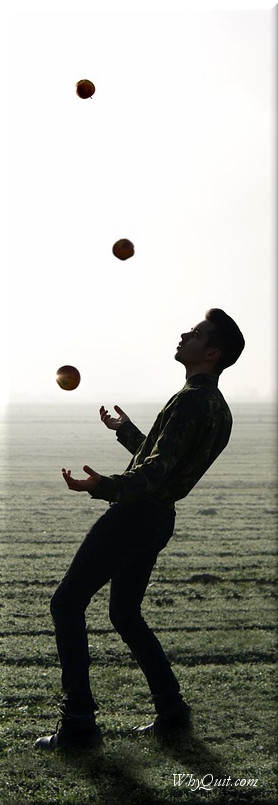
Distraction or diversion crave coping is any mental exercise or physical activity that occupies the conscious mind long enough to allow challenge to pass.
While little research on the topic, a 2014 study involving 84 heavy drinkers compared distraction-based coping to mindfulness coping, and no coping training. "Across groups, the initial exposure to alcohol cues" in a simulated bar environment "was associated with significant increases in craving, urge distress, and heart rate."
"Contrary to our prediction," the researchers admitted, distraction crave coping was "significantly more effective at acutely reducing craving and urge distress than the other 2 conditions." [1]
As true for all nicotine dependency recovery crave coping preparation, success is rooted in dreams of becoming and remaining nicotine-free. Coping evidences courage in taking steps toward making dreams come true.
Alphabet or counting association schemes demand focus and concentration. They provide an instant means of occupying the mind. An alphabet association scheme can be as simple as going through the alphabet while trying to associate each letter with a person, place, animal or food.
Take food for example. The letter "A" is for grandma's hot apple pie. "B" is for a nice crispy piece of bacon. "C" is for a rich and super moist chocolate cake. I challenge you to get to the challenging letter "Q" before 3-5 minutes pass and challenge begins subsiding.
Counting exercises can be as simple as counting backward from 350 by 7s. That would involve your mind doing 50 simple math calculations.
Consider playing a hand or two of solitaire or reach for a crossword puzzle. Can you draw? Try drawing your favorite person, pet, place, or thing. Sing your favorite song, reorganize a closet or drawer, look through your photo album, play with your pet, phone a friend, read a book or magazine, check your email, or do the dishes or a load of laundry.
Distraction isn't about avoiding a craving but about temporarily diverting your attention and focus until the intensity and risk of relapse subsides.
Physical distraction possibilities include turning to your favorite non-nicotine activity such as music or dancing, a brief period of physical exercise, going for a short walk or bike ride, taking a shower, or something as simple as brushing your teeth.
Should you ever feel a need to vent, try screaming into a pillow, squeezing a tree, or biting your lip. I promise, the pillow won't scream back, you won't hurt the tree, and your lip will heal.
And don't forget about pulling out and reviewing your list of reasons for commencing recovery. While doing so, reflect on possibly adding to the list those benefits not noticed or appreciated until after your healing was underway.
References:
All rights reserved
Published in the USA
